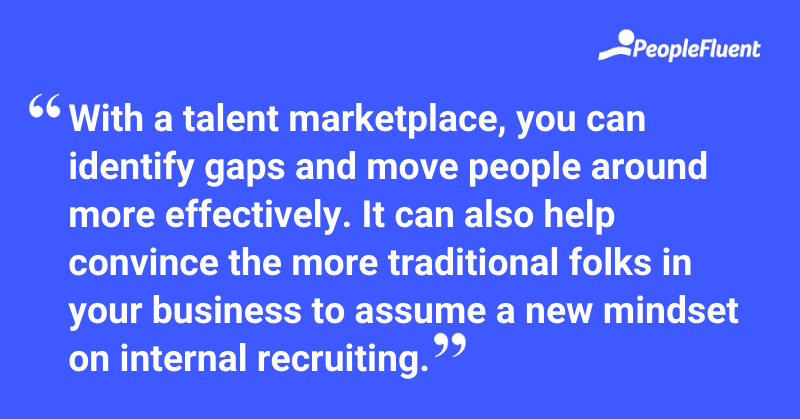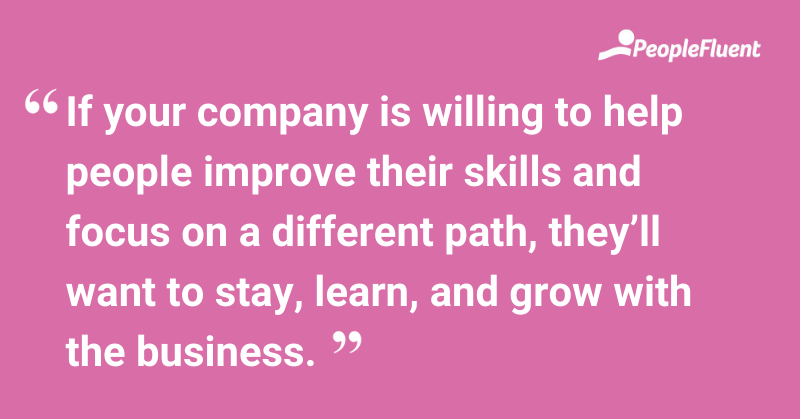Published: Feb 15, 2022Time to read: 4mins Category: Insights
Moving On Up: 3 Ways You Can Build a Talent Marketplace to Solve Internal Mobility Challenges
Table of Contents
Aside from the cost savings on recruiting, a strong internal mobility program can bring many benefits to your organization. With the right tech, tools, and strategy, you can successfully train existing staff in order to fill critical roles faster. Let’s take a look at how a talent marketplace can help you solve any challenges that your organization may be facing—now, or in the future.
Employee-led career development has become an even more important part of L&D’s role throughout the past two years. In fact, research from The 2021 Linkedin Learning report suggests that upskilling and reskilling should be a top priority. But, if you don’t know where your gaps are—or who has the needed skills to fill those gaps—where do you begin?
How will you know which employees are even interested in a lateral or upward move, or who is willing to engage with your career development programs?
1) First Things First: Get the Right Tech in Place
You need a central place where employees, line managers, and HR professionals in your business can all go to see which roles and skills are needed. This creates a home for any employee interested in reinventing themselves. And, it gives managers, HR professionals, and L&D teams the visibility needed to offer employee-led development opportunities. This is whether you’re looking for someone to fill a project that will last a few months and serve a critical need, or you’re in need of a quick hire and running into external recruitment issues.
This central place exists, and it’s called a talent marketplace or talent mobility platform. With a talent marketplace, you can identify gaps and move people around more effectively. It can also help convince the more traditional folk in your business to assume a new mindset on internal recruiting.

RELATED READING | ‘The State of Internal Mobility: 6 Emerging Trends for 2022’
2) Get L&D Involved in the Process
As we’ve mentioned, L&D should be prioritizing employee-led development by way of upskilling and reskilling. These types of L&D programs can help to solve your internal mobility challenges as they allow you to move people around the business faster by training and developing them at a rapid pace. When it comes to creating incentives for people to engage with your learning programs, career growth is at the center.
A talent marketplace isn’t just for junior employees or those looking to make a move. It’s also important for managers to take part in career development as a means to learn new hard and soft skills that can help them develop their teams. Getting everyone involved in the process and spearheading it via L&D, will create a collaborative movement that keeps staff, managers, and HR professionals aware of which opportunities are available.
HANDPICKED FOR YOU | ‘Surviving The Great Resignation: How Talent Mobility Tech Can Help Build a Future-Proof Talent Marketplace’
3) Change Your Mindset on Internal Recruitment
Another factor undermining the success of internal movement is your company’s mentality toward employees who want to reinvent themselves. If people feel their current title is holding them back from advancing (or even switching to a different department), they’re going to seek outside roles. This means your retention rate will take a hit—as well as team morale and productivity!
Career growth should be an important part of your overall employee experience. When people feel valued, they’re more likely to stay with the company longer. One way you can show staff that you value them and their skills is by investing in their career growth. A talent marketplace makes this easier as it helps you create career paths.
Career pathing should be used alongside your internal mobility efforts as it helps employees build a multi-directional roadmap. This means, for example, that John, a software engineer, could begin developing himself for either a director-level position or another engineering position on a different product or service offering.
It may take longer to completely shift the mindset around the advantages of internal versus external recruiting. However, doing so is worthwhile as it further proves to staff that they’re not just expendable resources. If your company is willing to help people improve their skills and focus on a different path, they’ll want to stay, learn, and grow with the business.

KEEP READING | ‘Team Me Up, Scotty! 4 Ways Talent Mobility Can Create an Out-of-This-World Employee Experience’
Ready for more insights on how to future-proof your organization?
To learn more about the many ways a talent marketplace can help you create better processes, fill skill gaps, and future-proof your company, listen to a recording of the recent webinar, ‘Building a Talent Marketplace for the Future With Josh Bersin’. Alternatively, get in touch to see how PeopleFluent can help.